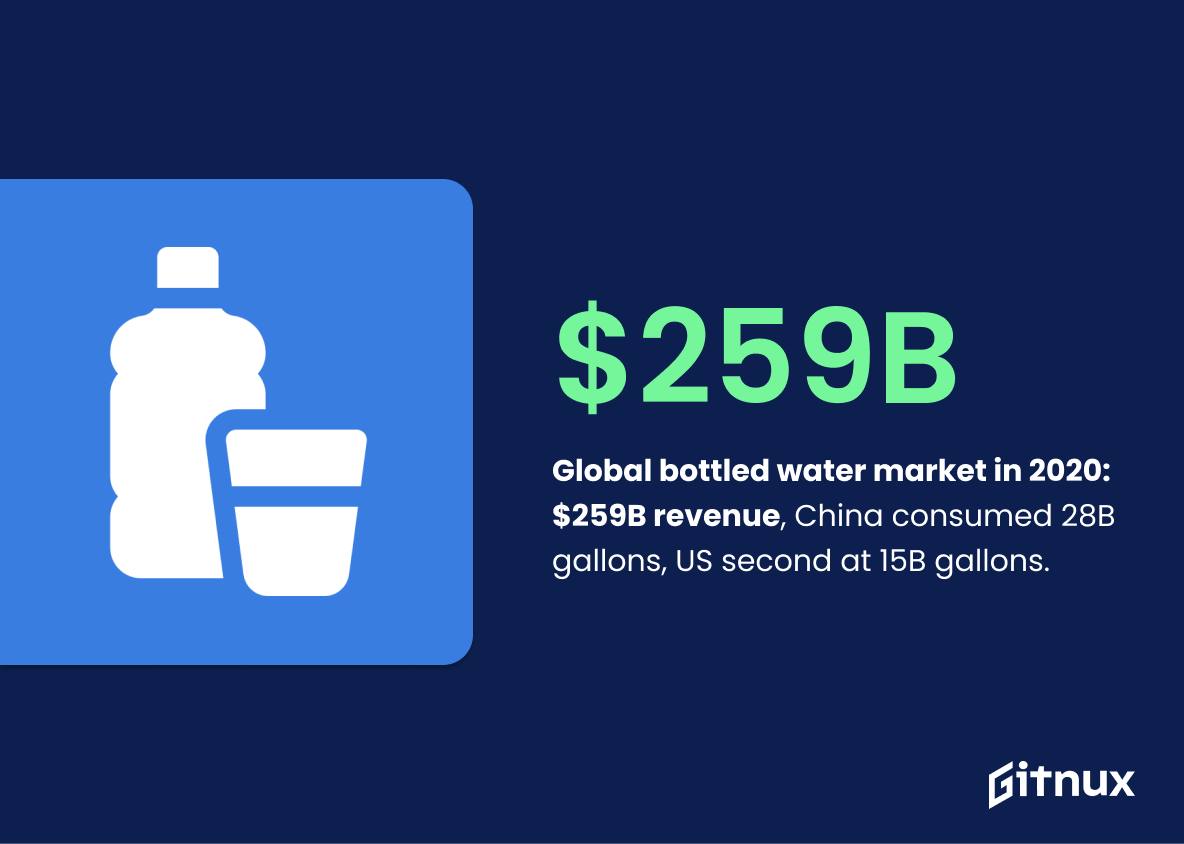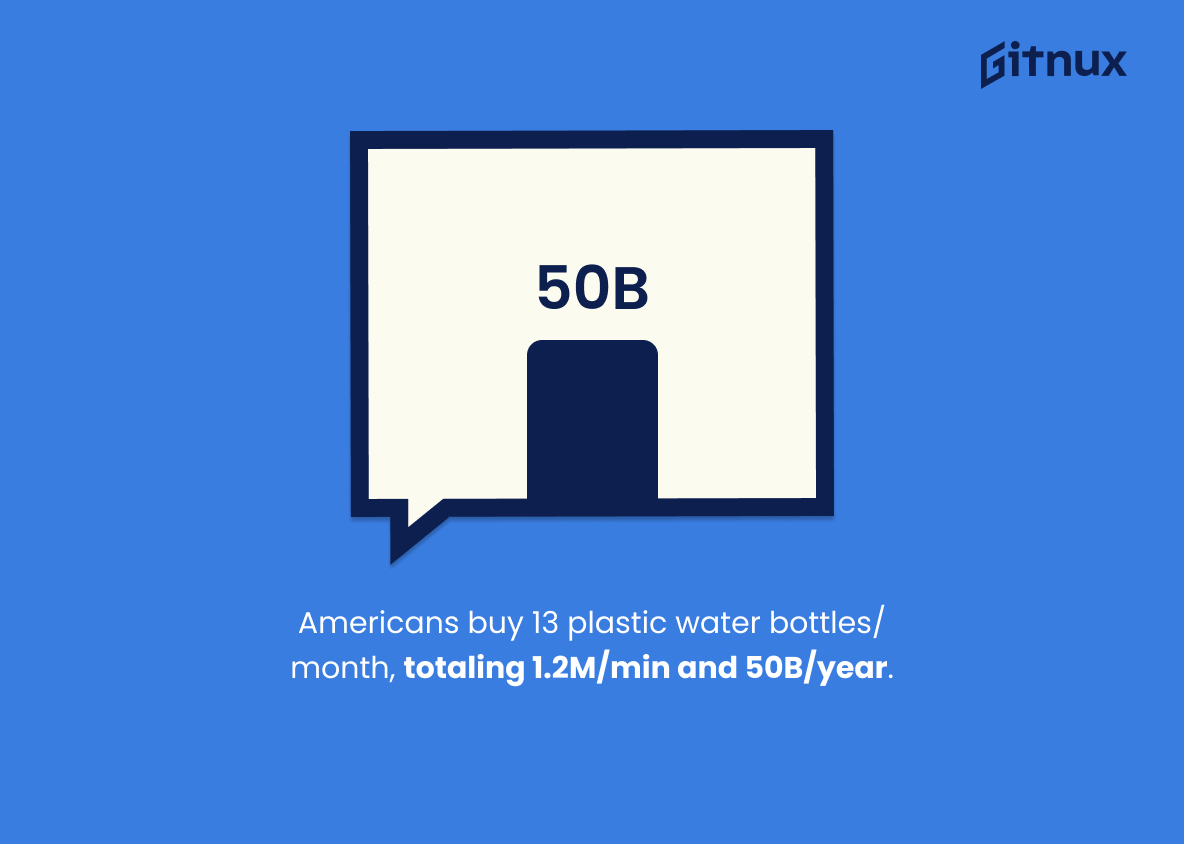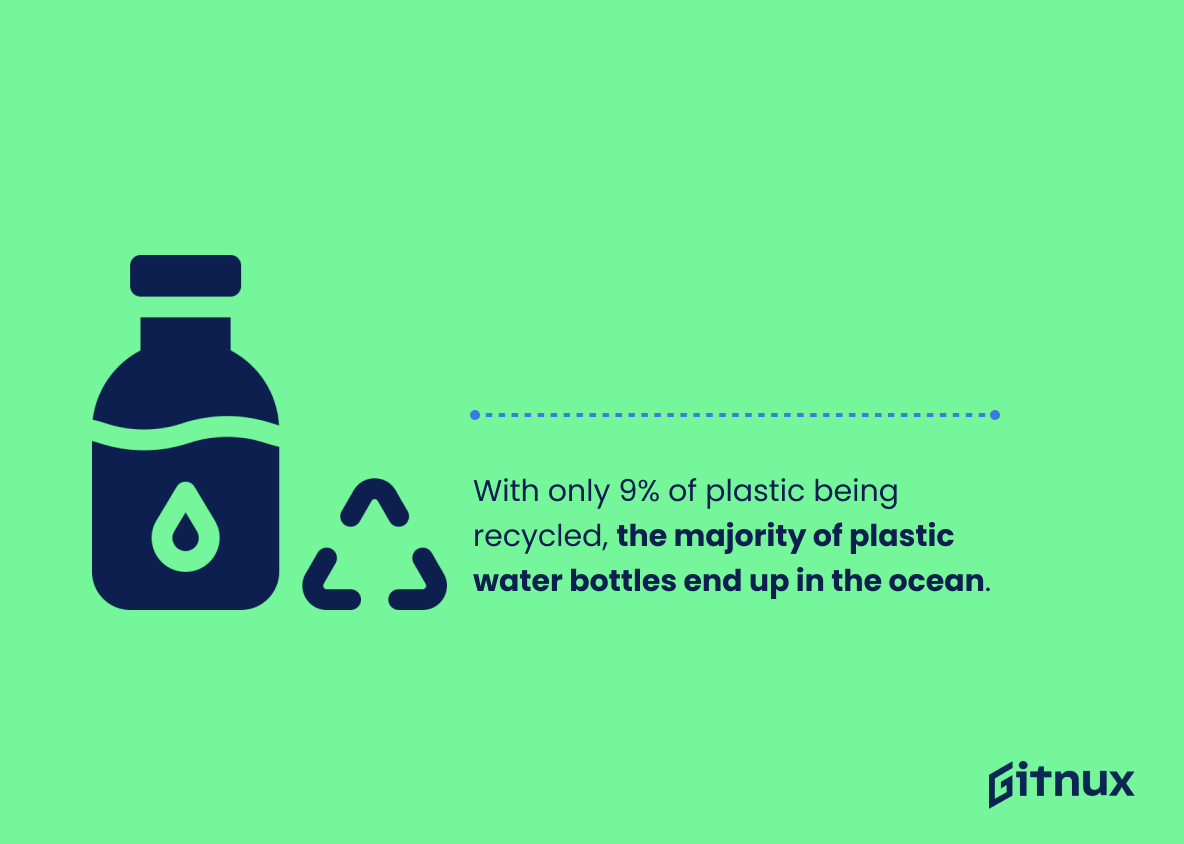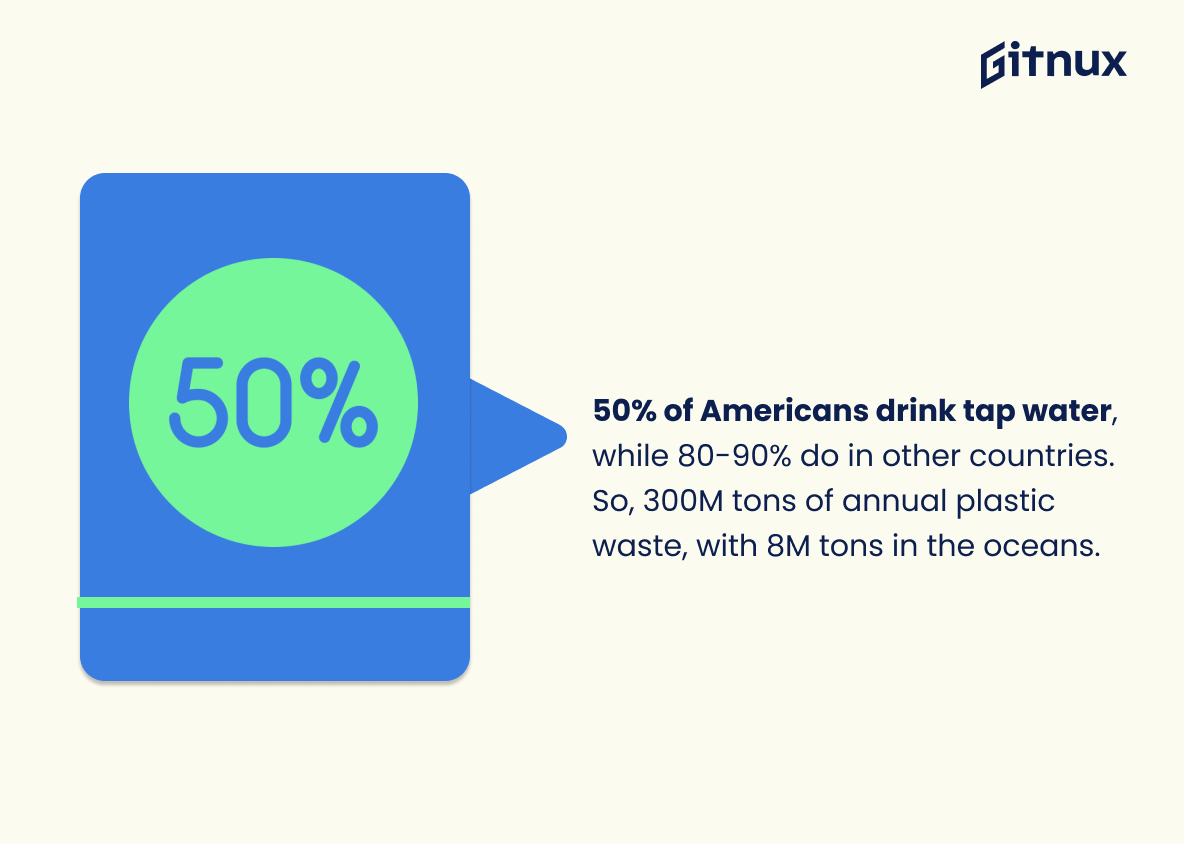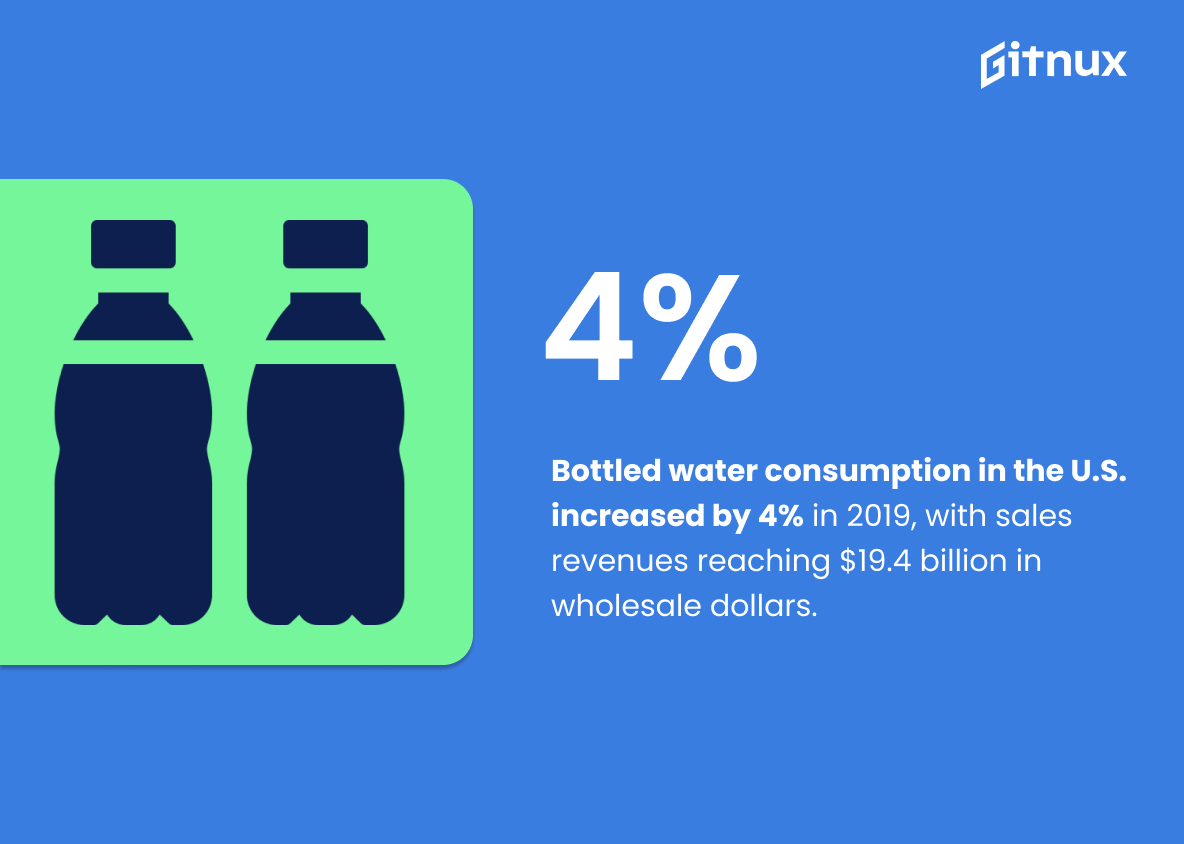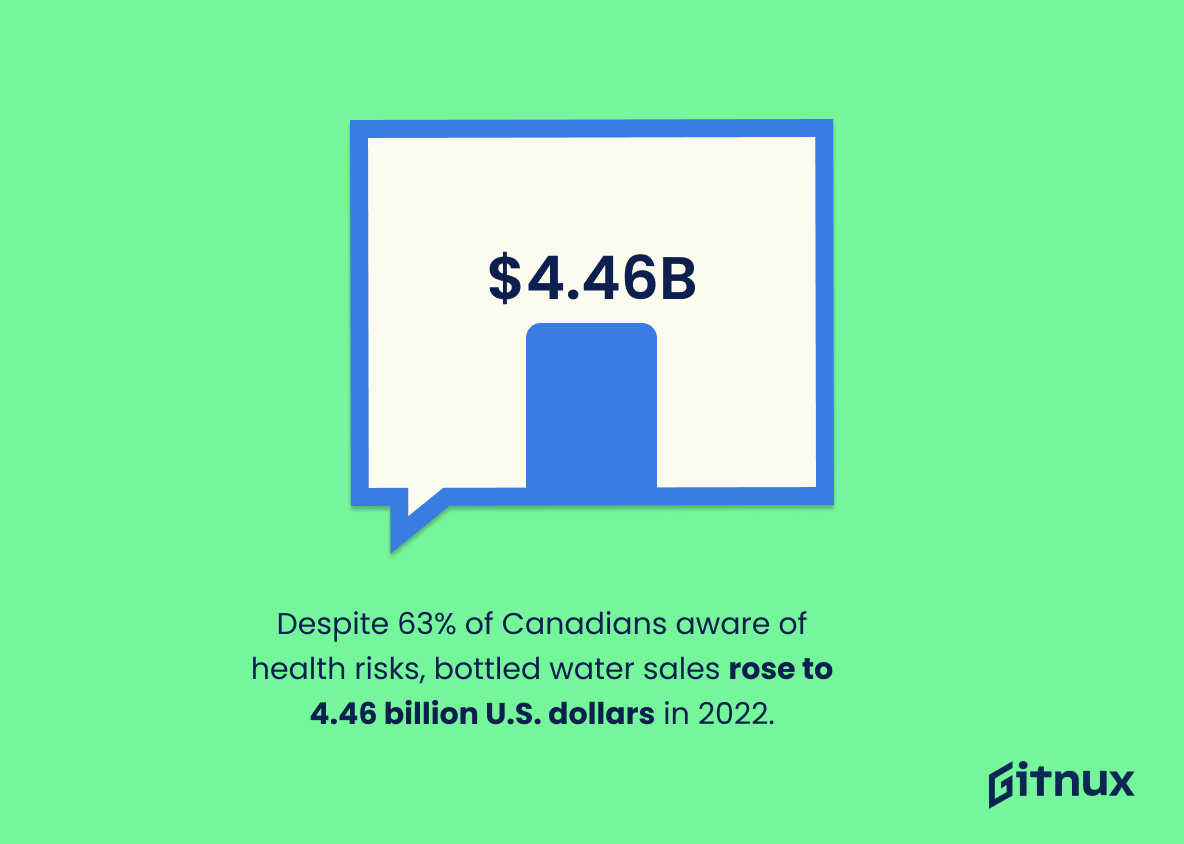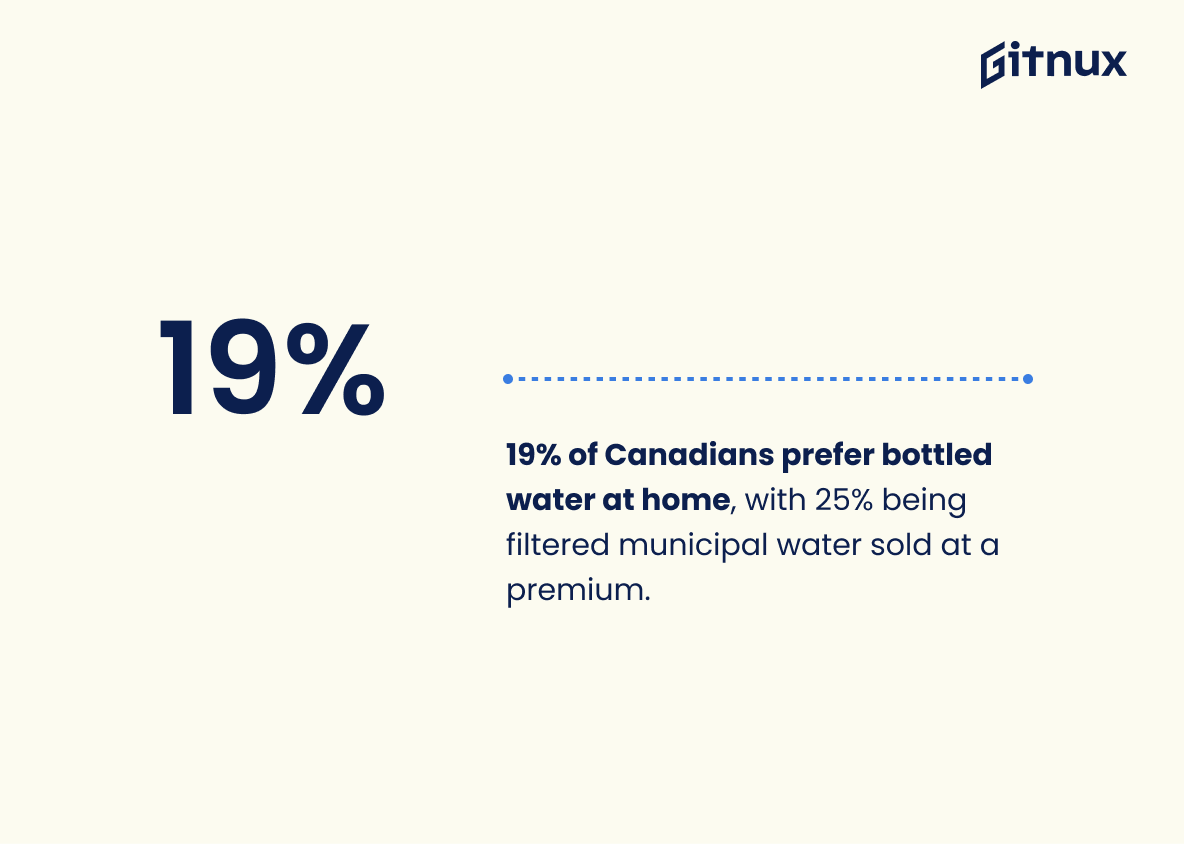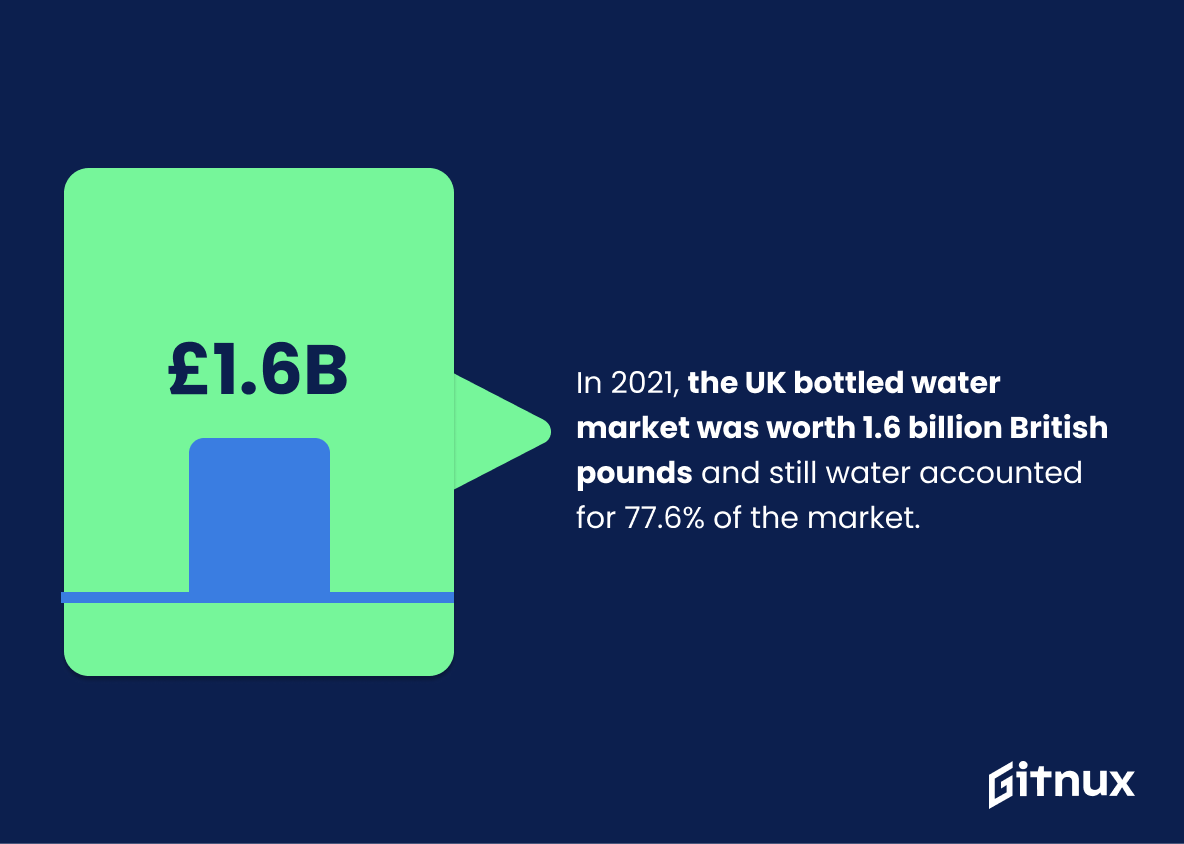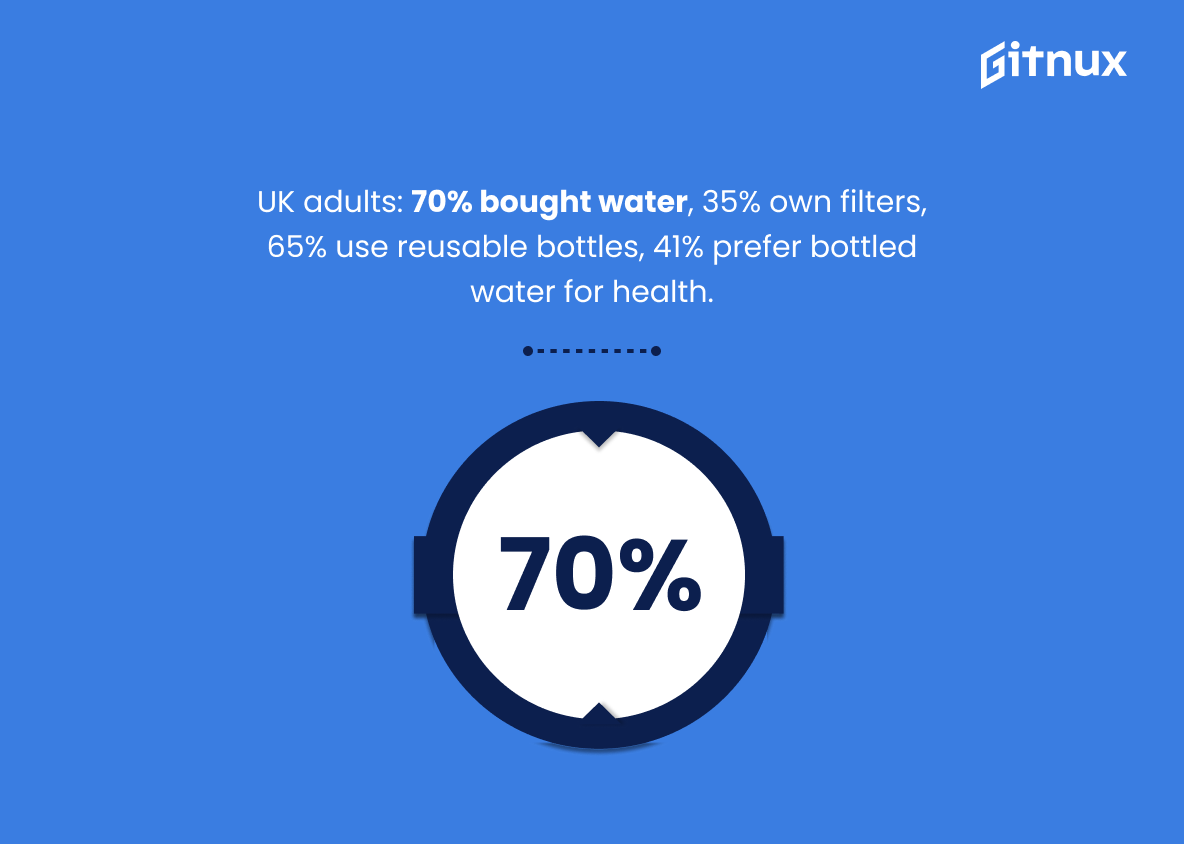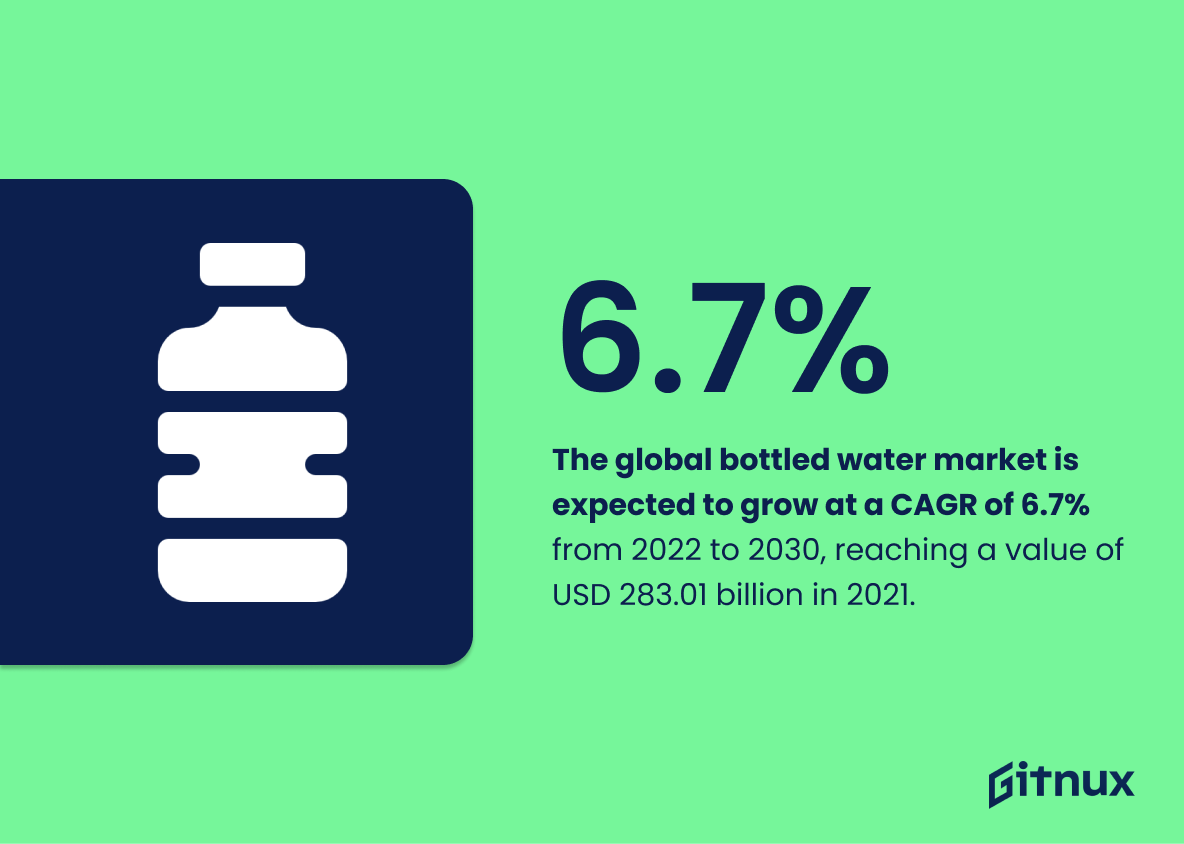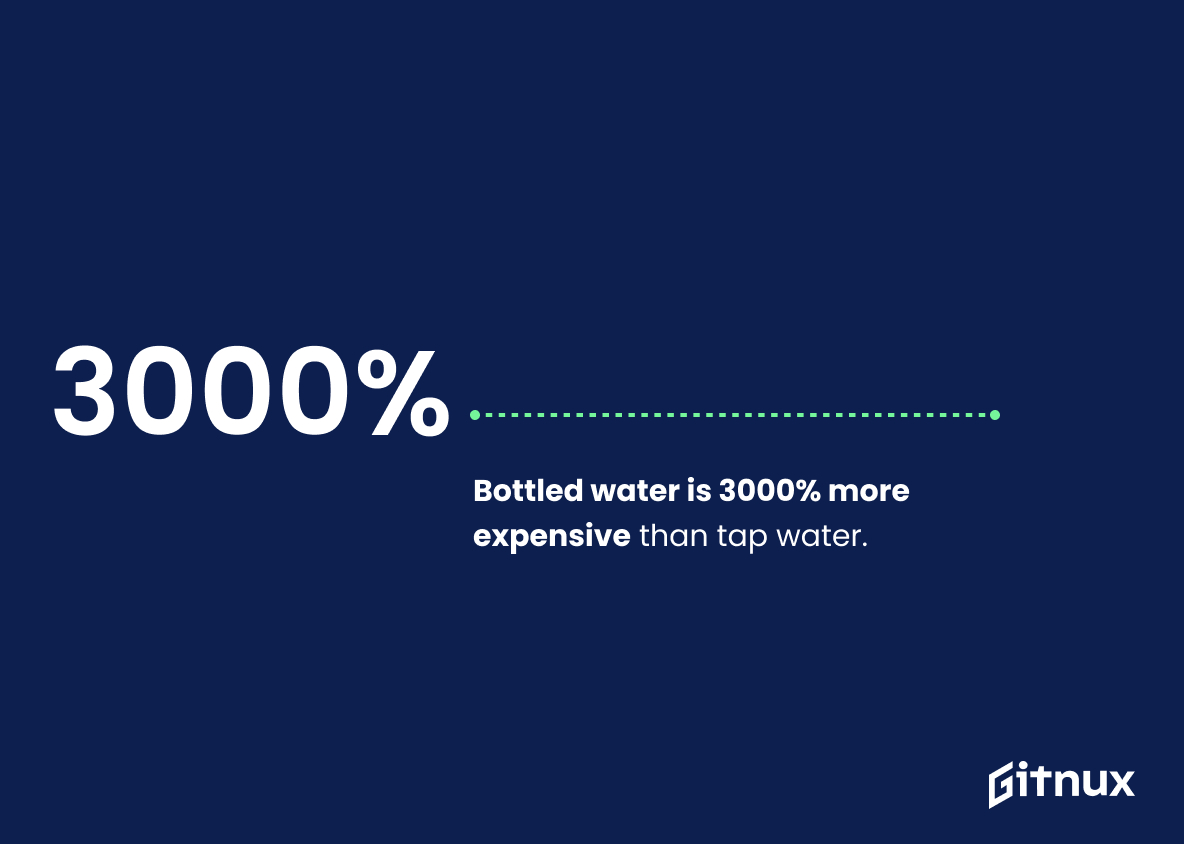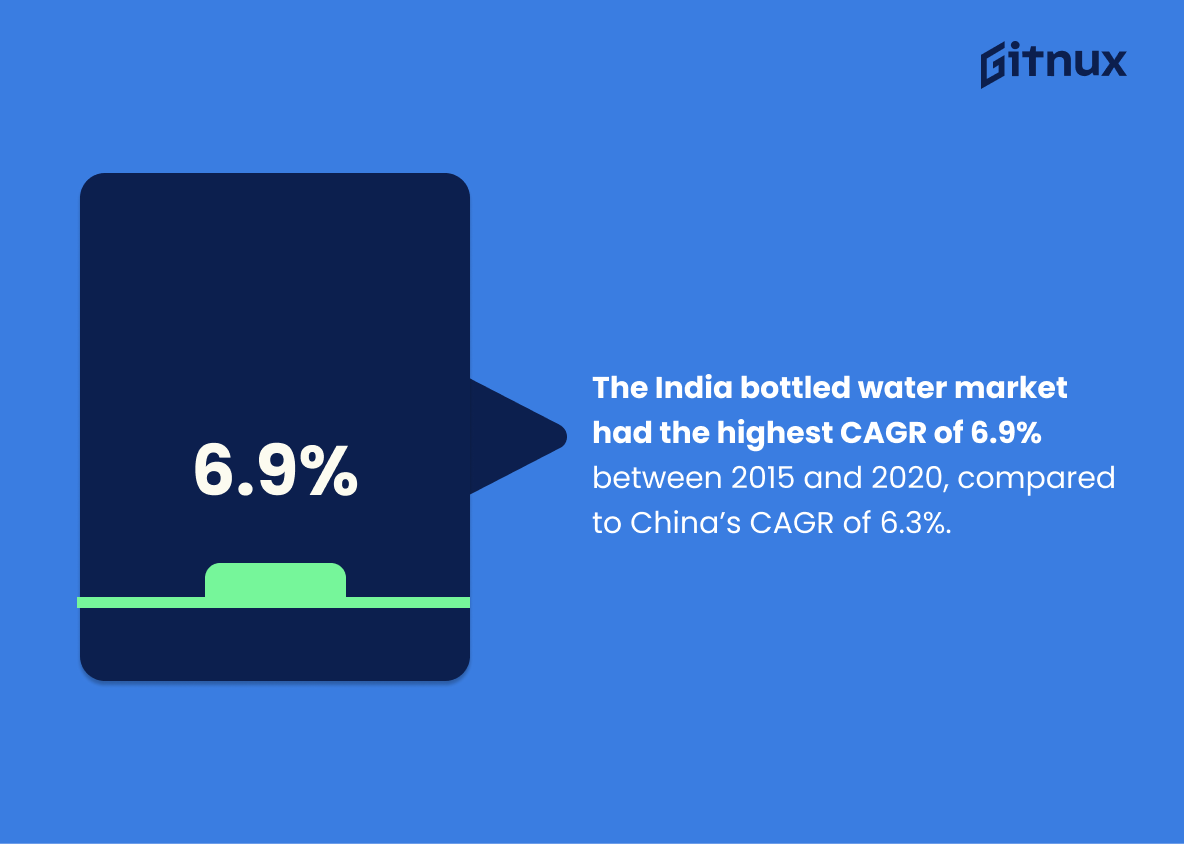The bottled water industry has grown exponentially in the last decade, with many people opting for bottled water over tap water for convenience and perceived health benefits. But what do the statistics say about the bottled water industry?
In this blog post, we will take a look at the latest industry statistics to get an understanding of the size and scope of the bottled water industry. We will also explore the environmental impact of bottled water and discuss the potential implications of these figures.
Bottled Water Industry: The Most Important Statistics
With only 9% of plastic being recycled, the majority of plastic water bottles are ending up in landfills or the ocean.
Consumers aged 35-44 are the most frequent consumers of bottled water.
Bottled Water Industry: Statistics Overview
In 2020, the global bottled water market generated a revenue of $259 billion, with China consuming the most at 28 billion gallons and the US coming in second at 15 billion gallons.
This matters because it shows the high demand for bottled water worldwide, with PET packaging being the most popular type of packaging.
Bottled water consumption in the United States reached an all-time high in 2020, with four main brands generating around one billion U.S. dollars in sales each. This is significant as it indicates that the U.S. is the largest bottled water consumer market, and that the industry is growing.
Americans purchase an average of 13 plastic water bottles per month, which adds up to 1.2 million bottles per minute and 50 billion bottles per year – this has a huge environmental impact as only 9% of plastic is recycled.
This statistic matters in the context of the Bottled Water Industry Statistics because it highlights the huge environmental impact of plastic water bottles.
With only 9% of plastic being recycled, the majority of plastic water bottles are ending up in landfills or the ocean.
This highlights the importance of using reusable water bottles to reduce plastic waste.
Only 50% of Americans drink tap water regularly compared to 80-90% in other countries, resulting in the production of 300 million tons of plastic waste each year and 8 million tons of plastic ending up in oceans every 12 months.
This matters in the context of Bottled Water Industry Statistics because it highlights the environmental impact of the industry, as well as the potential to reduce plastic waste by encouraging more people to drink tap water.
The Bottled Water segment is expected to generate US$342.40 billion in 2023, with an annual growth rate of 5.24%, and an average volume per person of 61.79 L.
This statistic matters in the context of the Bottled Water Industry Statistics because it provides an indication of the size of the market and its potential for growth. It also provides insight into the average consumption of bottled water per person, which can be used to inform marketing and pricing strategies.
Bottled water consumption in the U.S. increased by 4% in 2019, with sales revenues reaching $19.4 billion in wholesale dollars.
This statistic is important to the Bottled Water Industry as it shows that the industry is growing and that consumers are increasingly turning to bottled water as their beverage of choice. This growth in sales revenues indicates that the industry is profitable and that it is likely to continue to grow in the future.
63% of Canadian consumers believe drinking from plastic water bottles is not good for their health, yet bottled water sales have increased from 3.83 billion U.S. dollars to 4.46 billion U.S. dollars in 2022.
This matters in the context of Bottled Water Industry Statistics because it shows that despite the majority of Canadian consumers believing that drinking from plastic water bottles is not good for their health, the industry is still growing and is one of the most popular soft drink categories.
19% of Canadians drink bottled water as their main type of drinking water at home, with 25% of cases being filtered municipal water sold at a premium.
This statistic matters in the context of Bottled Water Industry Statistics because it shows the prevalence of bottled water consumption in Canada and the large amount of plastic bottles used each year. It also highlights the financial success of the industry, mainly through Nestlé and its brands.
In 2021, the UK bottled water market was worth 1.6 billion British pounds and still water accounted for 77.6% of the market.
This statistic is important because it shows the size of the UK bottled water market and the dominance of still water within it. This information is useful for companies looking to enter the UK bottled water market as it provides an indication of the size of the market and the types of products that are most popular.
It also provides an indication of the potential growth of the market in the future, which can be used to inform strategic decisions.
70% of UK adults have purchased a bottle of water in the last three months, 35% have water filter products in their home, 65% carry a reusable water bottle with them when out of home, and 41% drink bottled water because they believe it is healthier than other drinks.
This matters in the context of Bottled Water Industry Statistics because it shows that there is a high demand for bottled water in the UK, as well as an awareness of the benefits of using reusable water bottles and water filter products. This indicates that the bottled water industry is likely to remain strong in the UK, as consumers are willing to invest in these products.
The global bottled water market is expected to grow at a CAGR of 6.7% from 2022 to 2030, reaching a value of USD 283.01 billion in 2021.
This statistic is important because it shows the potential growth of the bottled water industry over the next 8 years. This information can be used by investors and industry leaders to make decisions about the future of the industry, such as where to invest resources and how to adjust their strategies to take advantage of the growth.
The global bottled water market size is predicted to increase from US$ 207.7 billion in 2020 to US$ 500.7 billion by 2030, with a CAGR of 9.2%.
This statistic is important because it shows that the bottled water industry is growing rapidly and is expected to continue to do so over the next decade. This growth is likely due to increasing demand for bottled water and the convenience of having access to it.
This statistic is important for companies in the bottled water industry to be aware of, as it can help them plan for the future and make decisions about how to best capitalize on the growth of the industry.
Bottled water has a 3,500 times higher impact on natural resources than tap water, according to scientists.This matters because it highlights the environmental impact of the bottled water industry, which is becoming increasingly popular despite improvements to tap water quality.
Bottled water is 3000% more expensive than tap water.
This statistic is important to consider when looking at the Bottled Water Industry Statistics because it shows the large discrepancy in price between tap and bottled water, which can be a major factor in consumer decisions when it comes to purchasing bottled water.
The India bottled water market had the highest CAGR of 6.9% between 2015 and 2020, compared to China’s CAGR of 6.3%.
This statistic is important because it shows that the India bottled water market is growing faster than the market in China, indicating that the industry is expanding and providing opportunities for growth. This could be beneficial for companies looking to invest in the bottled water industry in India.
The USA is the world’s leading consumer of bottled water, consuming 26 billion liters in 2004.This matters in the context of Bottled Water Industry Statistics because it shows that the USA is the largest consumer of bottled water, and thus has the most influence on the industry.
Danone is the largest bottled water company in the world, with annual sales of $28.727 billion, representing 10.2% of the global bottled water industry. This matters as it highlights the size and scope of the bottled water industry, which is estimated to be worth $283.01 billion and has an annual consumption of over 42.6 billion bottles in the U.S. alone.
Sparkling water has seen an 18% annual growth rate between 2020 and 2021, making it one of the fastest growing nonalcoholic beverage categories.
This statistic matters in the context of the Bottled Water Industry Statistics because it shows that sparkling water is becoming increasingly popular and is a growing market. This information can be used by companies in the bottled water industry to inform their strategies and investments.
62% of consumers prefer still bottled water, 38% prefer sparkling water – this matters in the context of the Bottled Water Industry because it shows that still bottled water is the more popular choice amongst consumers, and thus companies should focus their efforts on producing and marketing still bottled water.
The Bottled Water segment is expected to generate $342.40bn in revenue in 2023. This statistic matters in the context of Bottled Water Industry Statistics because it shows that the demand for bottled water is increasing, which is beneficial for companies in the industry as it will lead to increased revenue.
IBottling’s article states that the profit margin for bottled water plants can range from 15-60%, depending on the size of the plant. This matters in the context of Bottled Water Industry Statistics because it shows that there is potential for profitability in the industry, as long as there is a strategic business plan in place.
The bottled water market is expected to grow by 5.24% annually over the next 5 years.
This statistic is important for the bottled water industry as it indicates that the market is expected to grow in the coming years. This growth could lead to increased revenue for companies in the industry, as well as more opportunities for new entrants. Additionally, this statistic could be used to inform decisions about investments and strategies for the industry.
The bottled water market is estimated to reach a size of over USD 510 Billion by 2030, with a healthy CAGR of 6.8%.
This statistic is important for the bottled water industry because it provides an outlook of the market size and growth rate for the next decade. It is also useful for investors and companies in the industry to make informed decisions about their investments and strategies.
Bottled water is 3500 times worse for the environment than tap water, and if all of Barcelona switched to bottled water, 1.43 species would die each year. This statistic matters in the context of Bottled Water Industry Statistics because it shows the large environmental impact of bottled water compared to tap water.
This statistic can be used to inform people of the negative environmental consequences of using bottled water and encourage them to switch to tap water instead.
Disposable water bottles contribute to global warming, pollution, and the death of 1.1 million marine creatures annually. This is important because it highlights the environmental impact of the bottled water industry and the need for more sustainable alternatives.
Consumers aged 35-44 are the most frequent consumers of bottled water.
This statistic is important for the Bottled Water Industry because it indicates which age group is most likely to purchase bottled water. Companies can use this information to target their marketing and promotional efforts to this age group, as well as to tailor their product offerings to meet their needs.
Women make up the majority of bottled water drinkers, with 45% of 18-34 year old women and 44.6% of 35-54 year old women consuming it.
This matters in the context of Bottled Water Industry Statistics because it shows that women are the main demographic of bottled water drinkers, and thus the industry should focus its marketing efforts on women in order to maximize sales.
The average volume of bottled water per person is expected to reach 61.79 litres in 2023.
This statistic is important for the Bottled Water Industry because it shows the expected growth of the industry in the coming years. It also provides insight into the demand for bottled water and the potential for further growth. This information can be used to inform decisions about marketing, production, and other aspects of the industry.
China had the highest consumption volume of bottled water worldwide in 2020 at 27.8 billion gallons per person, while the US had 15 billion gallons. This statistic matters in the context of Bottled Water Industry Statistics because it shows the relative demand for bottled water between the two countries and can be used to inform decisions about production and marketing of bottled water in each country.
The global bottled water market size was valued at USD 217.66 billion in 2020.
The industry has seen a significant increase in demand over the past few years, indicating that more and more people are turning to bottled water as their preferred source of hydration. This is an important indicator of the industry’s success and provides valuable insight into the current state of the market.
The bottled water industry is expected to grow at a compound annual growth rate (CAGR) of 8.3% from 2021 to 2028.
It is expected to experience a significant surge in growth over the next seven years. This is an important indicator of the industry’s potential and a great opportunity for those looking to invest in the sector. It also highlights the increasing demand for bottled water, which is likely to continue to rise in the coming years.
The United States bottled water market is expected to reach $49.01 billion by 2025.
It is a lucrative and rapidly growing market. It is a clear indication that the bottled water industry is a major player in the global economy and is likely to remain so for the foreseeable future. This statistic is a valuable insight into the industry and provides a useful benchmark for businesses looking to invest in the sector.
In 2020, the average American consumed 43.7 gallons of bottled water.
Americans are increasingly turning to bottled water as their preferred source of hydration, and that the bottled water industry is thriving. This statistic is an important piece of evidence that can be used to illustrate the success of the bottled water industry.
Approximately 30% of bottled water consumers choose the product because of concerns about the safety of tap water.
The industry has been successful in creating a perception of tap water as unsafe, and that bottled water is the only viable alternative. This is an important insight into the industry’s marketing strategies and the effectiveness of their campaigns.
In 2019, the reusable bottled water segment accounted for 19.6% in terms of market revenue.
More and more people are turning to this eco-friendly option. It is a clear sign that the bottled water industry is adapting to the changing needs of consumers, who are increasingly looking for sustainable solutions. This statistic is a testament to the industry’s commitment to sustainability and its willingness to embrace new technologies and trends.
In 2020, the Nestlé Waters’ sales amounted to CHF 6.69 billion ($7.2 billion).
The company has been able to generate a significant amount of revenue in 2020, despite the challenges posed by the pandemic. This statistic is a clear indication of the strength of the bottled water industry and the success of Nestlé Waters in particular.
In 2020, the retail sales value of functional bottled water in the U.S. was approximately 175.36 million USD.
The industry is thriving and that consumers are increasingly turning to bottled water as a healthier alternative to sugary drinks. This statistic is a valuable insight into the current state of the bottled water industry and can be used to inform decisions about marketing, product development, and more.
The market share of PET plastic bottled water is projected to reach 84.4% in 2021.
PET plastic bottled water is set to become the dominant form of bottled water, with an overwhelming majority of the market share. This is a clear sign that the industry is thriving and that consumers are increasingly turning to PET plastic bottled water as their preferred choice.
By 2025, the global flavored bottled water market is expected to reach $29.6 billion.
The market is expected to experience tremendous growth, indicating that the industry is likely to be a lucrative one for investors and entrepreneurs. Furthermore, it highlights the importance of staying up-to-date with the latest industry trends and developments in order to capitalize on the opportunities that the market presents.
The Middle East and Africa bottled water market is expected to register a CAGR of nearly 6% during 2021-2026.
The industry is expected to experience significant growth over the next five years, indicating that it is a lucrative market for investors and entrepreneurs. This is an important piece of information for anyone interested in the bottled water industry, as it provides insight into the potential of the industry in this region.
The market value of bottled water in Canada reached CAD 2.45 billion in 2019.
This is a clear indication of the growing demand for bottled water in the country, and serves as a reminder of the importance of this industry in the Canadian economy.
In 2020, the largest share of the European bottled water market was held by the still unflavored water segment, with a 52.7% market share.
Still unflavored water is the most popular type of bottled water in Europe, accounting for more than half of the market share. This highlights the importance of understanding consumer preferences and trends in order to remain competitive in the industry. Furthermore, it provides insight into the potential for growth in the flavored water segment, as well as the potential for new product development.
The Indian bottled water market size is expected to reach INR 403.06 billion by 2023 at a CAGR of 19.25% (2020-2023).
The bottled water industry is a lucrative and profitable venture, and that it is likely to remain so in the foreseeable future. This statistic is a valuable insight for anyone interested in investing in the bottled water industry, as it provides a glimpse into the potential of the industry and its future prospects.
The global mineral water market is expected to reach $87.2 billion by 2027, growing at a CAGR of 8.72%.
The market is expected to grow significantly over the next few years, indicating that now is the perfect time to invest in the industry. With the right strategies and investments, businesses can capitalize on this growth and reap the rewards.
In 2020, nearly 66% of global consumers reported concerns about plastic waste when it comes to bottled water.
A majority of global consumers are aware of the environmental impact of plastic waste and are concerned about it. This is an important factor to consider when discussing the bottled water industry, as it highlights the need for companies to take steps to reduce their plastic waste and become more sustainable.
In 2020, per capita consumption of bottled water in China was 57 liters.
The Chinese population is increasingly turning to bottled water as their preferred source of hydration, which is a major boon for the industry. This is especially true when compared to other countries, where per capita consumption of bottled water is much lower. This statistic is a testament to the success of the bottled water industry in China and its potential for further growth.
By 2024, the Latin American still bottled water market is expected to reach $8.7 billion.
The industry is expected to experience significant growth in the coming years, making it an attractive investment opportunity for those looking to capitalize on the booming industry. Furthermore, it highlights the importance of the Latin American market in the global bottled water industry, indicating that it is a key player in the industry’s success.
In 2020, the bottled water segment held an 8% market share of the total beverage industry in Australia.
Despite the presence of other beverage options, bottled water still holds a significant portion of the market. This is an important piece of information for anyone looking to gain insight into the bottled water industry in Australia.
Conclusion
The bottled water industry is a booming business, with no signs of slowing down anytime soon. With the increasing demand for convenience and health-consciousness, the bottled water industry is set to continue its growth in the coming years.
The industry is also becoming more sustainable, with more companies investing in eco-friendly packaging and production methods. As the industry continues to grow, it is important to stay up to date on the latest industry statistics and trends to ensure that your business is staying ahead of the competition.
Bottled Water Industry Statistics: FAQs concisely answered
y = [“What is the global market size for bottled water?”,
“What are the major trends in the bottled water industry?”,
“What are the major players in the bottled water industry?”,
“What are the different types of bottled water?”,
“What are the health benefits of drinking bottled water?”]
z = [“The global market size for bottled water was estimated to be around USD 280 billion in 2019.”,
“The major trends in the bottled water industry include the increasing demand for convenience and health-conscious products, the rise of flavored and functional bottled water, and the use of innovative packaging materials.”,
“The major players in the bottled water industry include Nestle, Danone, Coca-Cola, and PepsiCo.”,
“The different types of bottled water include spring water, mineral water, sparkling water, purified water, and flavored water.”,
“The health benefits of drinking bottled water include hydration, improved mental clarity, and improved digestion.”]
References
1 – https://www.statista.com/topics/9561/bottled-water-market-worldwide/
2 – https://www.statista.com/topics/1302/bottled-water-market/
3 – https://www.earthday.org/fact-sheet-single-use-plastics/
4 – https://recycledelic.com/plastic-water-bottle-pollution-facts-statistics-2022/
5 – https://www.statista.com/outlook/cmo/non-alcoholic-drinks/bottled-water/worldwide
6 – https://bottledwater.org/bottled-water-market/
7 – https://www.statista.com/topics/3050/non-alcoholic-beverages-in-canada/
8 – https://tappwater.co/en/tap-and-bottled-water-in-canada/
9 – https://www.statista.com/topics/7151/bottled-water-market-in-the-uk/
10 – https://store.mintel.com/report/uk-bottled-water-market-report
11 – https://www.grandviewresearch.com/industry-analysis/bottled-water-market
12 – https://www.precedenceresearch.com/bottled-water-market
13 – https://www.theguardian.com/environment/2021/aug/05/environmental-impact-of-bottled-water-up-to-3500-times-greater-than-tap-water
14 – https://green.harvard.edu/tools-resources/green-tip/reasons-avoid-bottled-water
15 – https://www.statista.com/statistics/1091644/bottled-water-cagr-by-country-worldwide/
16 – https://www.container-recycling.org/index.php/issues/bottled-water/91-media/outsidenews/276-bottled-water-pouring-resources-down-the-drain-
17 – https://www.zippia.com/advice/largest-bottled-water-companies/
18 – https://powerbase.info/index.php/Aquafina
19 – https://www.everydayhealth.com/diet-nutrition/does-sparkling-water-count-as-fluid/
20 – https://naturalmineralwaterseurope.org/statistics/
21 – https://www.statista.com/outlook/cmo/non-alcoholic-drinks/bottled-water/worldwide
22 – https://ibottling.com/steps-to-marginally-maximize-profit-in-water-bottling-plant/#:~:text=A%20bottled%20water%20plant%20is,as%2015%25%20for%20small%20bottles.
23 – https://www.statista.com/outlook/cmo/non-alcoholic-drinks/bottled-water/worldwide
24 – https://www.globenewswire.com/en/news-release/2022/07/27/2486571/0/en/Bottled-Water-Market-Size-Worth-USD-510-Billion-by-2030-at-6-8-CAGR-Report-by-Market-Research-Future-MRFR.html#:~:text=filingsmedia%20partners-,Bottled%20Water%20Market%20Size%20Worth%20USD%20510%20Billion%20by%202030,by%20Market%20Research%20Future%20(MRFR)
25 – https://www.euronews.com/green/2021/08/05/bottled-water-is-3-500-times-worse-for-the-environment-than-tap-water-say-scientists#:~:text=in%20the%20City-,Bottled%20water%20is%203%2C500%20times%20worse%20for,than%20tap%20water%2C%20say%20scientists&text=Tap%20water%20is%20thousands%20of,bottle%20as%20it%20can%20hold.
26 – https://www.officeh2o.com/2020/02/27/why-are-disposable-water-bottles-harmful-to-the-environment/#:~:text=The%20water%20bottling%20process%20releases,times%20less%20than%20tap%20water.
27 – https://www.bevindustry.com/articles/87741-multicultural-generation-x-consumers-most-likely-to-drink-bottled-water-packaged-facts-reports
28 – https://www.sbdcnet.org/small-business-research-reports/bottled-water-industry/#:~:text=Also%2C%20according%20to%20American%20Demographics,old%20women%20consume%20bottled%20water.
29 – https://www.statista.com/outlook/cmo/non-alcoholic-drinks/bottled-water/worldwide
30 – https://www.statista.com/statistics/1307883/consumption-of-bottled-water-worldwide-in-2009/
31 – https://www.aarkstore.com
32 – https://www.nielsen.com
33 – https://www.futuremarketinsights.com
34 – https://www.ibisworld.com
35 – https://www.apnews.com
36 – https://www.ladatanews.com
37 – https://www.grandviewresearch.com
38 – https://www.reportlinker.com
39 – https://www.researchandmarkets.com
40 – https://www.statista.com
41 – https://www.mordorintelligence.com
42 – https://www.globalmarketanalyst.com
